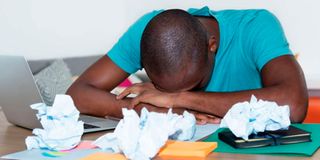Slow progress on campaign against sexual harassment of male journalists

Although male journalists are also victims of sexual harassment, their attitude and perception towards it makes it hard to break the cycle.
What you need to know:
- Some journalists say sexual harassment is no longer 'something to worry about at this time when media houses are sacking employees'.
- Media Owners Association of Kenya chairperson Agnes Kalekye says they are committed to creating a safe space for all their employees.
A year after I published the story on sexual harassment of male journalists, I revisit the subject to establish progress made towards addressing the problem.
Eleven of the 17 journalists I had interviewed have since left the newsroom, out of whom six got jobs in the public service and civil society, while the rest were laid off following the restructuring by media houses.
Of the six still in the newsroom, only two said they had in the past year attended training in sexual harassment prevention and response organised by either their media houses or organisations championing the rights of journalists in Kenya.
“Nothing. No training. We are getting used to it,” said one of the four who hasn’t received any training in the past year.
The rest said sexual harassment is "no longer something to worry about" at this time when media houses are sacking employees.
Although there are no new studies or data to show a trend in the prevalence of sexual harassment in the newsrooms, previous data imply an epidemic yet to be contained.
In 2020, City, University of London found that 77.5 per cent of female journalists and 29.7 per cent of their male colleagues in Kenya had experienced sexual harassment.
In the same year, the Media Council of Kenya (MCK) conducted a survey, sampling 61 female journalists and 57 males working in print, radio, TV and online platforms.
Sixty-two per cent of the journalists said they had either been sexually harassed at their workplaces or knew a colleague who had been a victim.
In terms of vulnerability to sexual harassment off their workplaces or during assignments, 73 per cent of the female journalists said they were highly likely to be violated, while 27 per cent of male said they, too, were highly likely to be victims.

Data in the 2021 Africa report on the status of sexual harassment by the World Association of News Publishers ((Wan-Ifra) further depicted a toxic working environment for journalists.
Eighty-three journalists participated in the survey: 62 women and 20 men, with one being non-gender conforming.
It established that 30 per cent of the male had experienced verbal sexual harassment and 20 per cent physical sexual harassment.
For women, 79 per cent experienced verbal sexual harassment. And 52 per cent physical sexual harassment.
Media stakeholders have, however, made notable progress towards addressing sexual harassment in the newsrooms, in general. There haven’t been specific interventions targeting the male journalists, most of whom, the interviews reveal, suffer in silence.
Last year, the Journalists for Human Rights (JHR), in partnership with the Association of Media Women in Kenya, launched a model anti-sexual harassment policy. And so far, according to JHR, nine media stations from Nairobi, coastal and Western regions have adopted the policy.
At the legislative level, the government has yet to adopt International Labour Organisation (ILO) Violence and Harassment Convention No.190 of 2019, popularly known as ILO C190.
In December last year, during an Echo Network Africa consultative forum of anti-gender-based violence activists, National Gender and Equality Commission chairperson Joyce Mutinda indicated that she had engaged the office of the Attorney General to fast-track adoption of the convention.
Upon ratification, the convention requires the country to create a “world of work” free from violence and harassment, which comprise unacceptable behaviours and practices, or threats aimed at causing physical, psychological, sexual or economic harm.
In a past interview, Dinnah Ondari – the manager for press freedom, safety and advocacy at MCK, a statutory body that regulates the media and conduct of journalists – said male journalists don’t see sexual harassment as an issue.
Yet, from its 2020 survey, the 21 per cent of the sampled 118 female and male journalists said sexual harassment affected their productivity.
Media Owners Association of Kenya chairperson Agnes Kalekye says they are committed to creating a safe space for all their employees. She said employers have made efforts to train its staff in sexual harassment, especially in identifying and reporting it.
Further, they have collaborated with media experts to not only help those without the policy to develop them but also review the existing ones for improvement. Ms Kalekye encouraged any staff member who has fallen victim to report, hoping that the cases would drop if disciplinary action is taken against perpetrators.
Wan-Ifra in its report recommends that employers give employees the options of filing official and unofficial complaints if they are to counter sexual harassment.
Additionally, it urges media houses to allow people to report cases anonymously as this gives employees the ability to expose such cases without having to reveal their own identity.





